Key takeaways:
- Complex rhythms enhance communication and emotional expression in music, making them essential for creating shared experiences.
- Mastery of complex rhythms can be achieved by breaking down patterns, using body percussion, and practicing with various musical styles.
- Effective rhythm practice includes recording oneself, using technology like rhythm apps, and engaging with instructional resources online.
- Revisiting foundational rhythms can support the understanding and execution of more intricate patterns, fostering growth in musical skills.
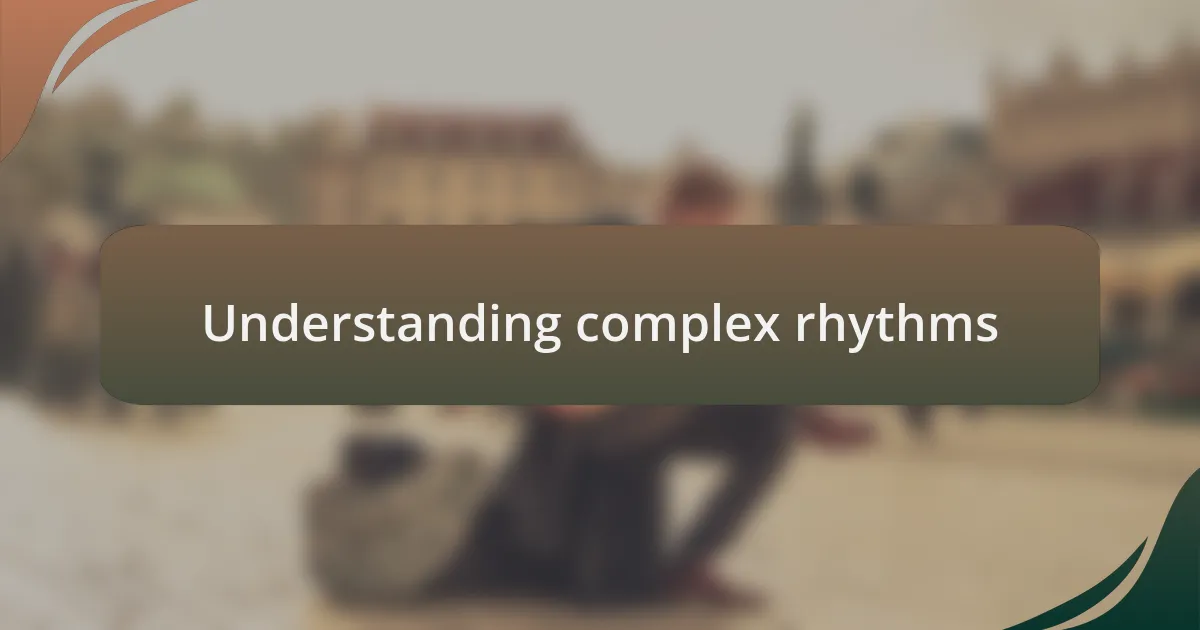
Understanding complex rhythms
Understanding complex rhythms can be both exciting and daunting. I remember the first time I encountered a piece that featured polyrhythms—my brain felt like it was doing acrobatics! It’s that initial confusion that often leads to breakthroughs, making the process incredibly rewarding.
Have you ever tried tapping out a rhythm that doesn’t fit neatly into 4/4 time? That’s where the beauty of complex rhythms shines. I was once in a rehearsal, trying to synchronize with my bandmates while navigating an uneven 7/8 pattern. The feeling of aligning with others amidst chaos is electrifying, reinforcing the idea that complex rhythms are about communication, not just individual skill.
As I delved deeper into these intricate patterns, I started to realize that understanding them isn’t just about counting beats; it’s also about feeling the music’s pulse. I often practice by clapping out these rhythms or using a metronome set to unusual subdivisions. This hands-on approach transforms my initial anxiety into confidence, proving that mastery comes through exploration and patience.
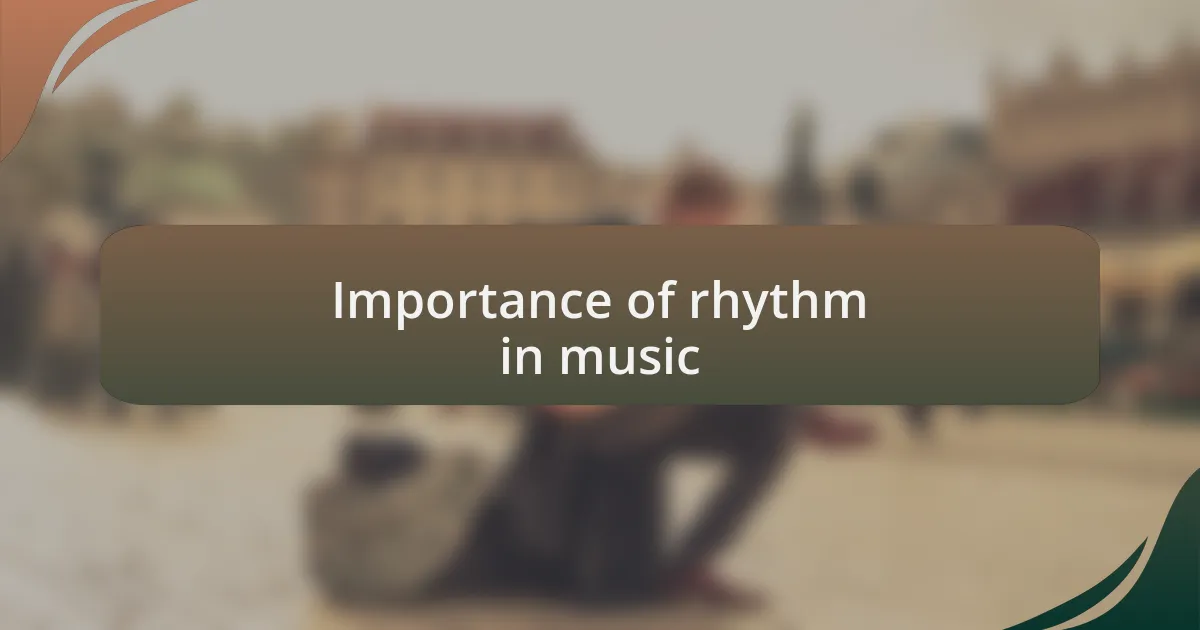
Importance of rhythm in music
Rhythm is the heartbeat of music. Without it, melodies would lose their structure and meaning. I recall a moment at a music workshop where we were all tapping our feet to a steady beat, and I was struck by how this simple act connected us. It reminded me that rhythm is essential for creating a shared musical experience, acting as a foundation upon which melodies and harmonies can flourish.
I remember struggling with feeling the groove in a new piece, which had an unusual time signature. As I focused on the rhythm, something clicked, and I could hear how it made the music pulse with life. Isn’t it fascinating how rhythm can evoke emotions and convey messages that words sometimes can’t? I believe that mastering rhythm allows us to express ourselves more profoundly, unlocking new dimensions of creativity.
Moreover, rhythm enhances our ability to communicate through music. When I jam with friends, it’s often the rhythm that sparks spontaneous improvisations. Have you noticed how a well-placed pause can create tension and anticipation? It’s moments like these that remind me that rhythm isn’t just a technical element; it’s a vital tool for emotional expression and connection in every musical endeavor.
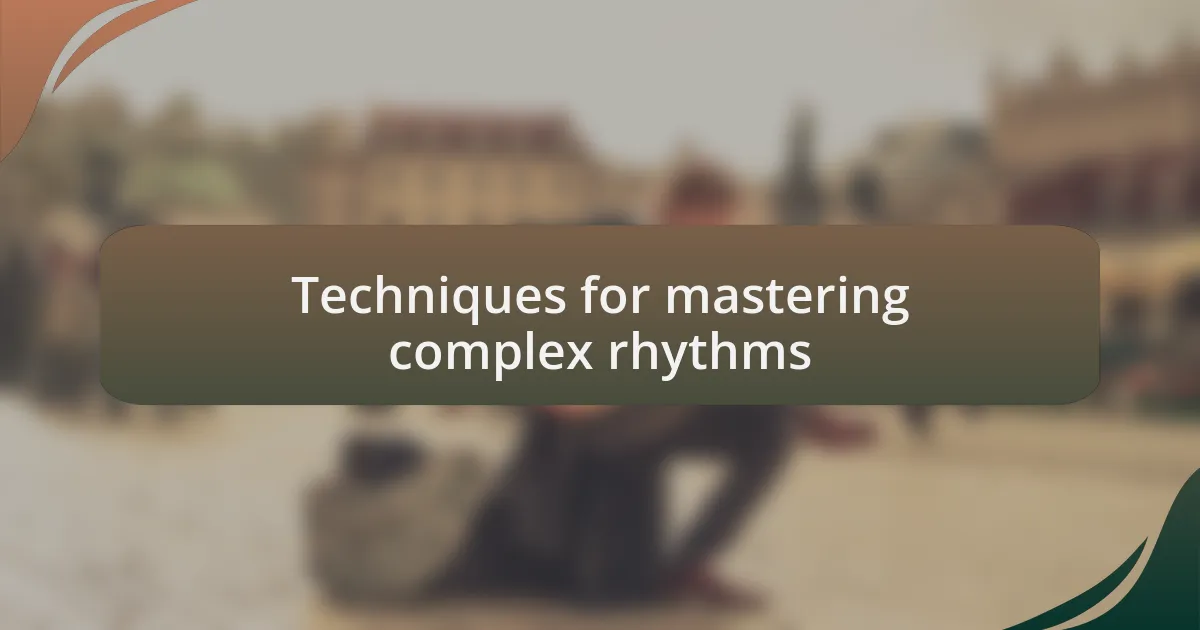
Techniques for mastering complex rhythms
When it comes to mastering complex rhythms, one technique that has worked wonders for me is breaking down the rhythm into smaller, digestible sections. I often use a metronome to practice slower speeds, allowing me to focus on one segment at a time. It’s amazing how isolating just a few beats reveals the intricacies I might otherwise overlook, and I encourage you to give this a try. Have you experienced a similar revelation when dissecting a challenging piece?
Another method I find effective is incorporating body percussion into my practice routine. Clapping, snapping, or even stomping in time with the rhythm helps to internalize the beat. I distinctly recall a rehearsal where we all engaged in body percussion, turning an intricate rhythm into an uplifting group activity. It was a joyful reminder that rhythm can be both a personal challenge and a communal celebration.
Finally, I can’t stress enough the value of listening to a variety of genres and rhythmic styles. Immersing myself in music that features complex rhythms has broadened my understanding and appreciation. I remember listening to a jazz track and being captivated by how the drummer played against the time signature, which inspired me to experiment with similar techniques in my own playing. What songs or genres have you explored that opened your eyes to different rhythmic possibilities?
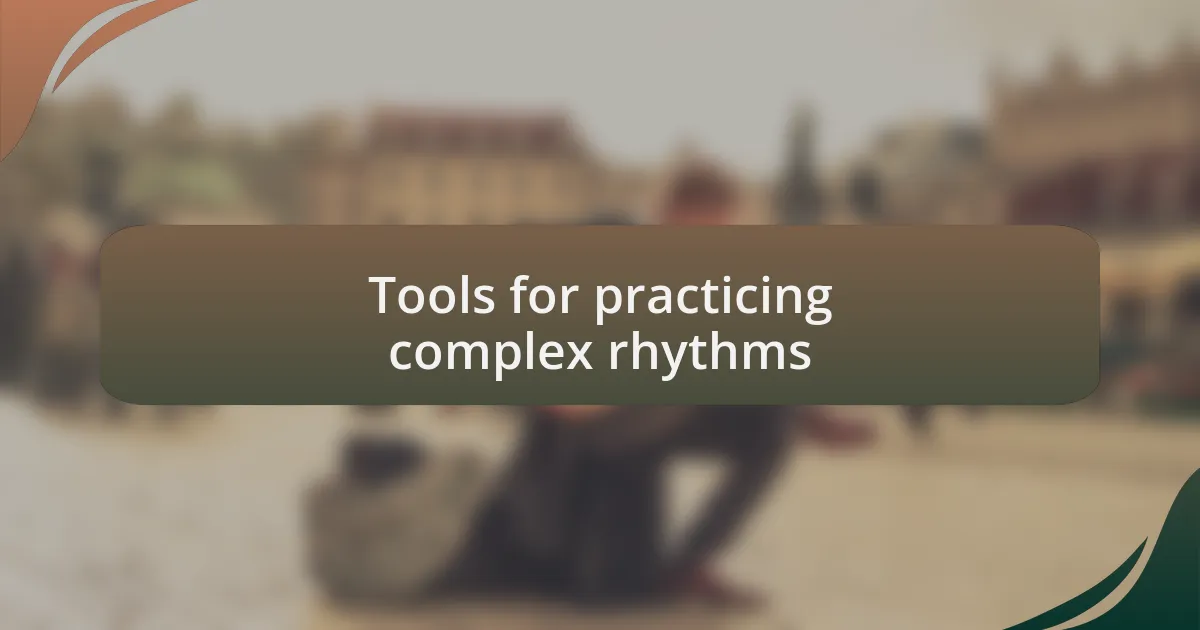
Tools for practicing complex rhythms
When it comes to tools for practicing complex rhythms, I find that using rhythm apps can be incredibly beneficial. These apps often have features that allow you to slow down recordings while maintaining pitch, so you can hear every nuance in a challenging passage. I vividly recall using one such app during a late-night practice session. The moment I slowed down a tricky section, it felt like a light bulb went off in my head—suddenly, the rhythm made perfect sense.
Another invaluable tool I’ve come across is the use of drum machines or sequencers. These devices provide a steady beat and allow me to layer different rhythms. I once created a loop of complex syncopations that pushed my timing to the limits. Working with a drum machine not only helped me tackle intricate beats but also added an element of fun and creativity to my practice. Have you ever tried experimenting with technology in your rhythmic practice?
Lastly, I can’t overlook the power of visual aids, like rhythmic notation charts or videos. I remember a time when I printed out a challenging rhythm and annotated it with my notes. The physical act of writing it down clarified the patterns for me in a way that just practicing didn’t. It was like mapping out a treasure hunt; every note created a path to uncovering the rhythm’s hidden gems. What tools have you used that provided clarity and insight in your own rhythmic journey?
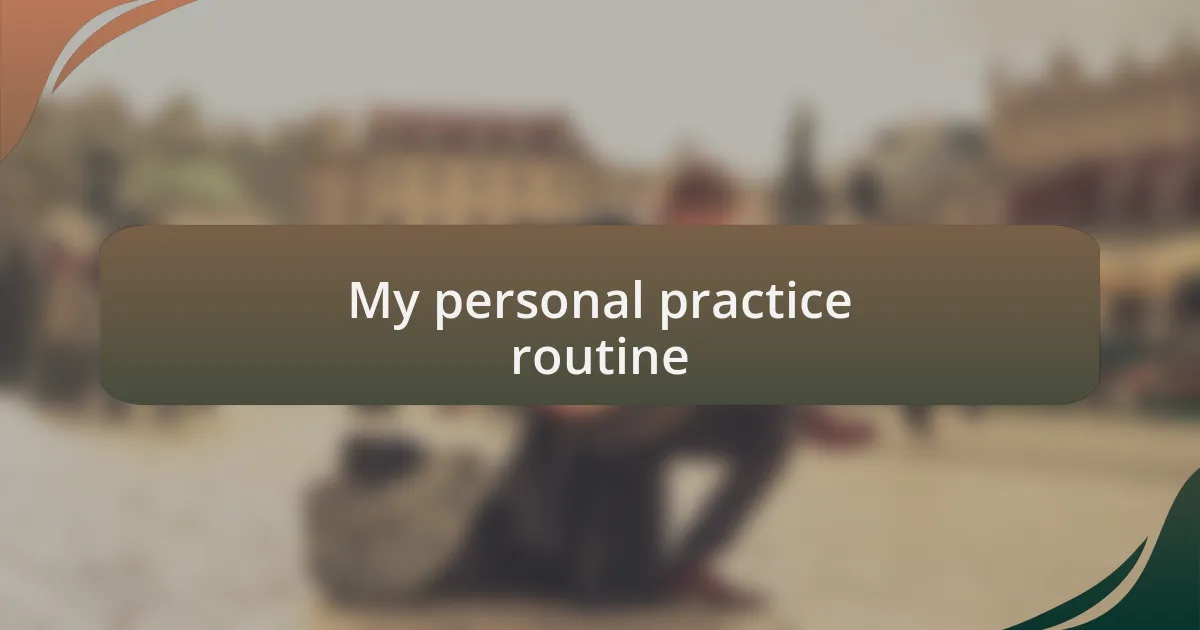
My personal practice routine
My practice routine incorporates a mix of focused sessions and playful experimentation. On days when I’m feeling particularly inspired, I dive into challenging rhythms, often setting a timer for 20-minute bursts. The intensity of these focused periods keeps me engaged, and I’ve found that taking short breaks to process what I’ve learned sparks new ideas. Have you ever noticed how stepping away for just a moment can lead to breakthroughs?
I also schedule time to revisit simpler rhythms that I’ve mastered. It might seem counterintuitive, but I enjoy layering these foundational patterns under more complex passages. For example, the last time I recorded myself playing I was surprised to hear how well the familiar rhythms supported the newer, intricate ones. Does revisiting the basics serve as a springboard for your own growth too?
Another key aspect of my routine is playing along with music that features complex rhythms. It’s fascinating how immersing myself in different styles puts me in sync with various rhythmic feel. One memorable afternoon, I jammed along with a fusion band, and the experience filled me with excitement as I navigated syncopations that were new to me. I encourage you to dive into your favorite genres—what new rhythms might you discover along the way?
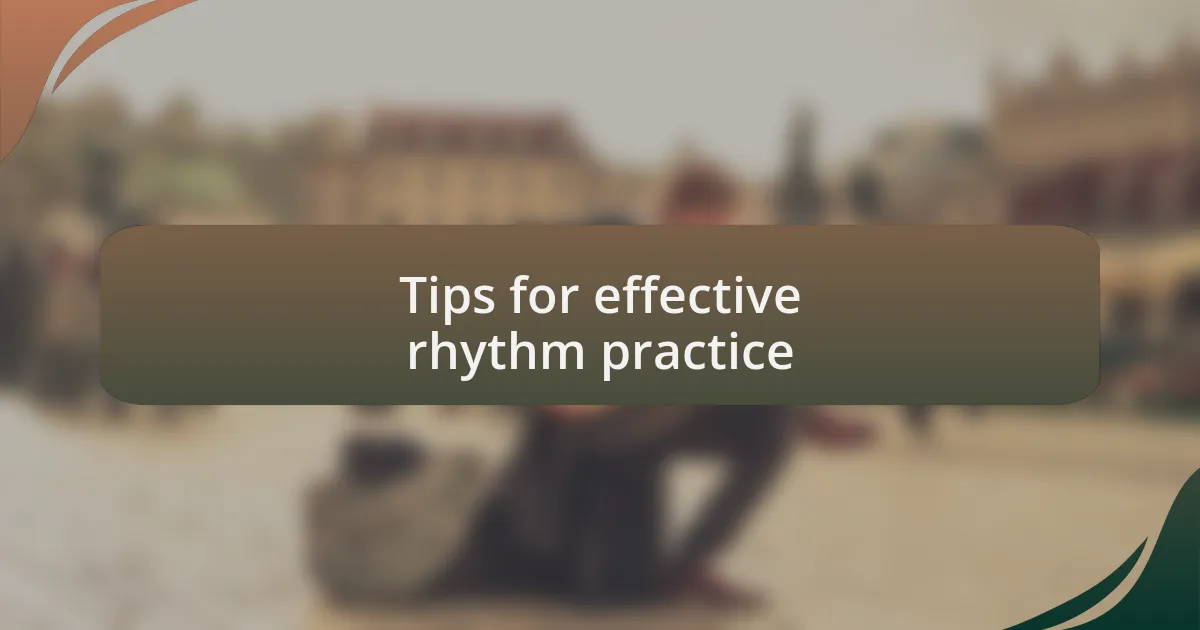
Tips for effective rhythm practice
When practicing complex rhythms, I find that breaking them down into smaller sections can be incredibly helpful. I often focus on just a few beats at a time, playing them slowly to ensure I understand the nuances. Have you ever experienced the “aha!” moment when a tricky passage suddenly clicks? It’s profoundly rewarding!
In my journey, I’ve discovered the value of incorporating physical movement while practicing rhythms. I sometimes tap my foot or even use body percussion to feel the pulse internally. This method not only reinforces the rhythm but also brings an element of fun to my practice. Isn’t it fascinating how connecting our bodies to the music can enhance our overall understanding?
Recording myself while playing complex rhythms has been an eye-opener too. I listen back not just for accuracy but also to identify where I can improve my groove. One day, I was shocked to realize how a slight hesitation disrupted the flow, which motivated me to tighten up my timing. Have you ever spotted something unexpected in your recordings that pushed you to adjust your approach?
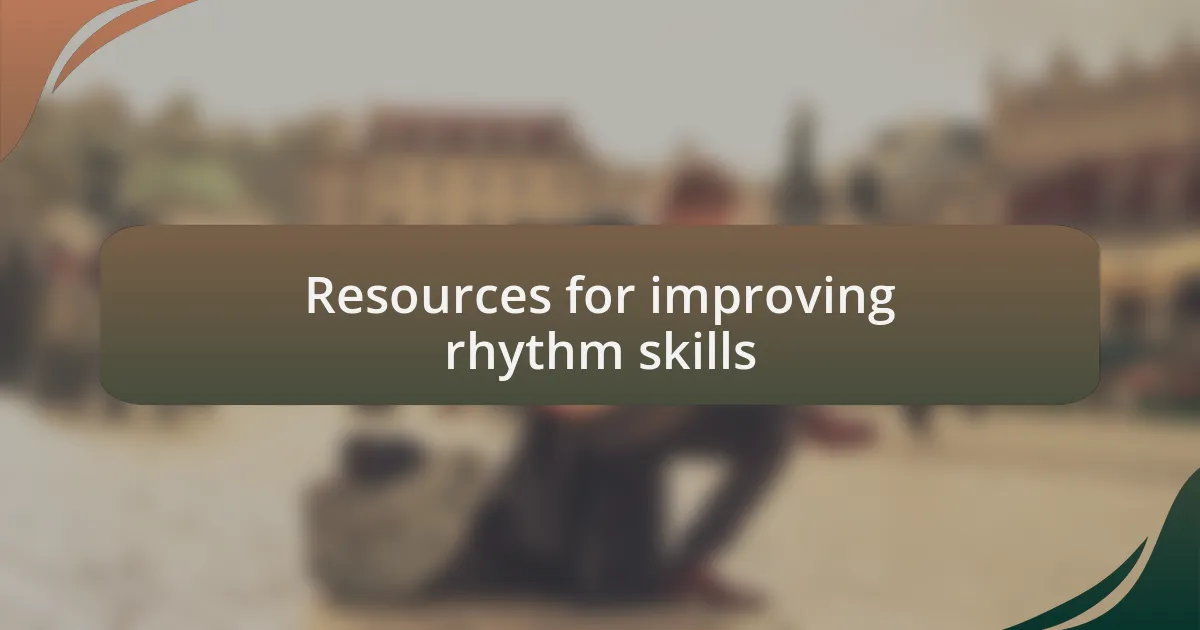
Resources for improving rhythm skills
When it comes to resources for improving rhythm skills, I often turn to online platforms like YouTube for instructional videos. There’s a wealth of creators out there dedicated to rhythm exercises. I remember watching a tutorial that broke down complex patterns into manageable chunks, making it so much easier to grasp. Have you tried following along with an online lesson? It can be quite the game-changer.
I also love using metronome apps with varying time signatures. It’s fascinating how adjusting the tempo can challenge me in different ways. One time, I set a metronome to triplets, and it felt like a whole new world opened up. I was so engaged that before I knew it, I had practiced for over an hour! Isn’t it interesting how simple tools can lead to hours of productive practice?
Lastly, I often explore rhythm books that offer exercises and play-along tracks. I recall the first time I picked up a book focused on polyrhythms; it was both challenging and exhilarating. Flipping through the pages, I found rhythms that seemed impossible at first, yet practicing them steadily turned frustration into confidence. Don’t you love that feeling when you go from confusion to clarity?